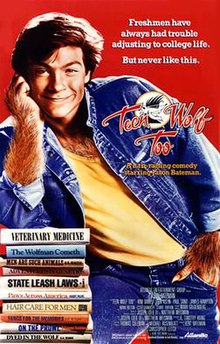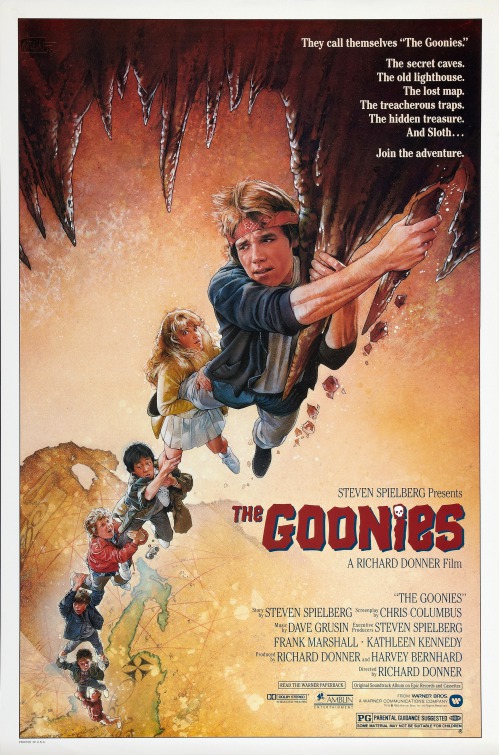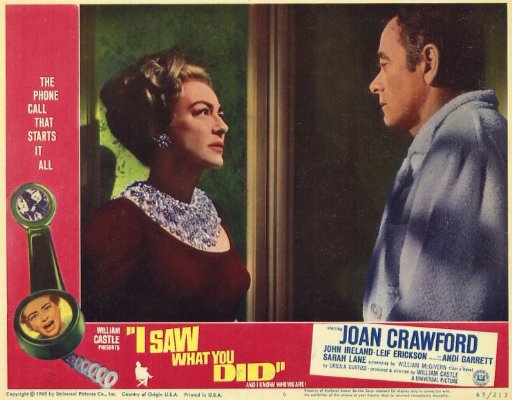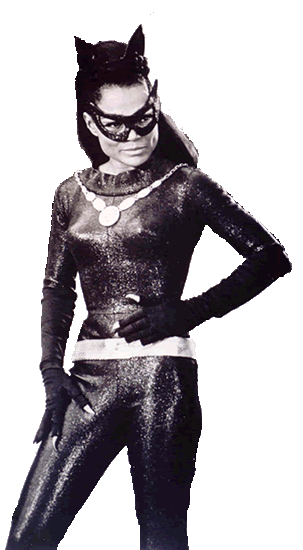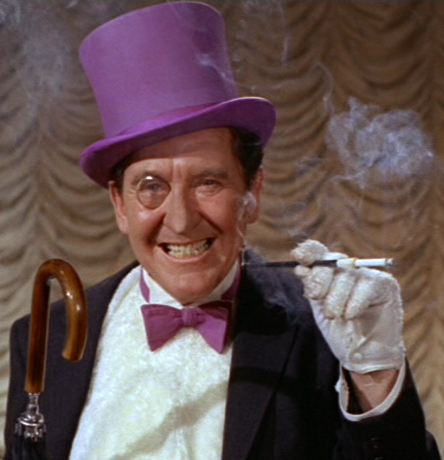Teen Wolf Too! Ugh! When I first bought a DVD player, one of the first DVDs I purchased was Teen Wolf. The only downfall was that it was a double feature DVD, which meant I had to purchase Teen Wolf Too as well. Teen Wolf is not a great movie, but compared to Teen Wolf Too it is a masterpiece. No word is adequate enough to describe just how terrible Teen Wolf Too is; it's an atrocity against the human race. It's 95 minutes of sheer torture with a ridiculously overqualified cast doing their best not to look embarrassed.
I've always theorized that Teen Wolf Too was originally supposed to be Teen Wolf 2, and further the adventures of Scott Howard (Michael J. Fox) as he took on college. However, when Michael J. Fox turned down the script (because it was friggin' awful), the filmmakers created a new character, Todd, and cast a Michael J. Fox-like actor in the role. It was during this time frame (1987) that Jason Bateman was starring in the dreadful sitcom The Hogan Family and he was the real life brother of Michael J. Fox's Family Ties co-star, Justine Bateman. The filmmakers probably looked at these two factors and shouted, "EUREKA! We found the next Teen Wolf!" Bateman would later prove to be an enormously gifted comedic actor, but he's absolutely dreadful in this film. Of course, it doesn't help that he is burdened with one of the worst scripts in cinematic history.
Todd Howard, the cousin of Scott (played by Michael J. Fox in the first film), is extremely nervous about starting his first day of college. The werewolf gene has seemingly skipped him, but his Uncle Harold (Scott's father) keeps reminding him that he could be late a bloomer. Why is Scott's father in Teen Wolf Too? Well, Todd's going to need someone to dispense some advice to him when shit hits the fan and Harold was obviously a logical choice. In theory, it's supposed to provide the audience with a nostalgic link to the first film. "Hey, look! It's Scott's dad!"
Whenever Harold is onscreen we're supposed to have warm and fuzzy memories of the relationship he had with Scott. The problem is that Harold is hardly in the film and is fairly superfluous to the overall narrative. Harold isn't the only returning character from the first film, there are a few others as well.
Todd has been accepted into Hamilton University on an athletic scholarship, despite the fact that he has never played a single sport in his entire life. "Why is this?" you yawn...er ask. Well, turns out the Hamilton's boxing coach is none other than Coach Bobby Finstock, Scott's high basketball coach from the first film. He recommended the athletic scholarship for Todd on the assumption that Todd is a werewolf like his cousin. His high hope is that Todd's lycanthropic powers can turn around the struggling boxing team, the pride and joy of Hamilton University. Why would the college dean hire a high school basketball coach to turn around Hamilton's boxing team? The movie never really delves into this question, instead the audience is asked to take it at face value. The boxing team is the top priority on Dean Dunn's list, he believes that it will help bring back school spirit. He gives Finstock an ultimatum, either get the team back on track, or you're out of a job. Coach Finstock just shrugs away the dean's threats, because he is more focused on eating a sandwich. It also doesn't help that Coach Finstock is played by a different actor, Paul Sand, who seems merely content on aping Jay Tarses' performance from the first film.
Todd arrives at his dorm room and finds that his two roommates are...SURPRISE...Scott's best friend, Stiles (played by a different actor, Stuart Fratkin), and Scott's former basketball teammate, Chubby (played by the same actor, Mark Holton). Todd is at a disadvantage as Stiles and Chubby seem to know everything about him, but he knows nothing about them. Like Finstock, Stiles is hoping to take advantage of Todd's lycanthropic prowess. In the first film, Stiles made a fortune selling Teen Wolf merchandise at basketball games, while Scott/ Teen Wolf was lighting up the court. He hopes Todd will help him rake in more cash and score with some hot college girls, as well. Harold is naturally less than enthused to see that Stiles is Todd's roommate, but he puts on a brave face. Stiles offers up a peace offering by giving Harold a McDonald's cheeseburger (in a Styrofoam container). Harold glances at the Styrofoam container and then tosses it to passing college student. The college student is extremely happy about this and thanks Harold. Then he adds, "Got any fries?" This is funniest bit in the entire film and it takes about a second of screen time; and occurs within the first ten minutes of the film.....OH, MAN! This is going to be a LONG 95 minutes.
Stiles comes across as being a refugee from an early 1980s sex comedy. He is constantly scheming to get laid, but always fails. His latest scheme is to leech off Todd's new found fame and even that backfires on him. He is at first elated when Todd turns into The Wolf, but eventually he grows tired of the cocky persona that Todd acquires.
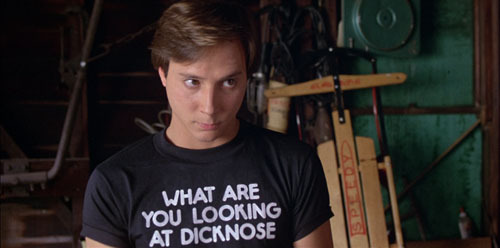 |
| BEFORE. Stiles - Teen Wolf |
 |
| AFTER. Stiles - Teen Wolf Too |
Todd isn't all that interested in athletics, his true passion is science and he wants to be a veterinarian. Todd needs to change his schedule after Stiles has mucked it all up by registering for him, one of the classes is Woman's Volleyball. Todd asks Professor Brooks if he can add her class and she most happily obliges him. He seems to have found a kindred spirit in Professor Brooks. It's also at this juncture in the movie that Todd meets his love interest, Nicki (Estee Chandler), the hot nerdy girl. In the real world, Nicki would probably turn heads where ever she went, but in parallel universe of Teen Wolf Too, only Todd seems to be aware of her existence. Nicki is, indeed, gorgeous, but she commits TWO unforgivable cinematic crimes:
1) She occasionally wears glasses. Nicki is spectacle free for most of the film, but she dons them enough for her to labeled as a "freak." If an attractive woman has just one tiny flaw in the movies, people will avoid her like the plague. See also: Rachael Leigh Cook in She's All That.
2) She dresses in a very conservative attire. Nicki wears fuzzy sweaters and poodle skirts. She looks like she walked straight out of the 1950s. Her appearance is more fitting for an episode of Leave It To Beaver than an 1980s teen comedy.
All in all, Nicki is an extremely sweet and lovable girl, which means that the happiness her and Todd share is going to be shattered with the arrival of a cold hearted temptress. The temptress comes in the form of Lisa, a bitchy blonde with a southern accent. Todd's first transformation into the Wolf occurs while he is dancing with Lisa at a Meet and Greet for College Freshman. She is wearing a form fitting dress, which exposes ample cleavage, and Todd becomes aroused by this. Also in a tow is Lisa's slutty brunette friend, Emily. Initially, both women reject Todd, but once he becomes the big man (WOLF) on campus, they are both clinging to his arms. Todd (in wolf form) even engages in a menage 'a trois with the two woman, though this heard, rather than seen. Stiles arrives at his dorm room, only to find it is locked, he hears giggling coming from within and knocks on the door. Emily answers it, wearing nothing but her bra and panties, Stiles is elated. However, Todd tells Stiles to go away and Emily shuts the door on his face. However, even the bad girls grow tired of Todd's antics and go back to their boyfriend, Gustavson, who is...SURPRISE AGAIN...the star boxer on a rival boxing team. How much do you want to bet that him and Todd will face off in the movie's climax?
Todd's second transformation happens during a boxing match. Todd is getting the crap beat out of him by his opponent and falls to the ground. All hopes seems lost, but then Todd's eyes start glowing red. Then he leaps to his feet in full werewolf mode. He turns the tables on his stunned opponent and wins the day. After this great victory, he becomes a campus hero and a party is held in his honor. He then regales the crowd by singing The Contours classic, "Do You Love Me (Now That I Dance)." It's five of the most agonizing minutes in cinema history. Everyone seems to be having a good time, except for the angelic Nicki.
Man, I wish I lived in the parallel world of Teen Wolf Too, because maybe, just maybe I could get Nicki on the rebound. But alas, I'm stuck in horrible reality. The audience is then treated to endless montages of Todd's rise and fall as the Wolf. He goes from being a beloved icon to being a complete pain in the ass to the people close to him.
I will say this for Teen Wolf Too, it does a better job of establishing the dichotomy between Todd (good) and The Wolf (bad) than it's predecessor. In the first movie, Scott becomes a tad bit cocky when he's the Wolf, but he never develops into a full out asshole. Whereas in Teen Wolf Too, once Todd becomes the Wolf he turns into a complete douche bag; he completely disregards the safety of a bicyclist when he essentially runs the poor sucker off the road. To Todd it's an amusing prank, but to the bicyclist it's a moment of complete terror. In the the first film, Scott was smitten with Pamela and hoped to be in a long term relationship with her. After their first date is over, Scott comments about how angry Mick was and Pamela says you can't blame him, as he is her boyfriend. This completely blindsides Scott, who was convinced that this was the start of something beautiful. In Teen Wolf Too, Todd has no such ambitions when it comes to Lisa and Emily, it's purely a carnal thing. I'm probably putting more thought into this movie than the actual filmmakers did, I suggest I move along.
After Lisa and Emily, and most of his friends have abandoned him, Todd calls Harold for some advice. James Hampton some how manages to sell the scene with his sincere performance, despite the horrible material he has to work with. Todd then makes good with Nicki and Professor Brooks, whose class he has been neglecting. We are then treated to a montage of Todd, with Nicki's help, cramming for his finals, set to the Real Life song "Send Me An Angel."
Naturally, Todd aces his finals, thanks to the power of love. He then faces Gustavson in the ring and decides to do it as himself and not as the Wolf, despite the fact that Gustavson is twice his size. Todd takes quite a punishment, but refuses to give up. Eventually his persistence pays off as he beats Gustavson and pulls off the greatest upset in fictional sports history since a guy by the name of Rocky Balboa beat the dreaded Russian Ivan Drago. Like Rocky Balboa, Todd is like a "piece of iron" that doesn't know the meaning of the word quit. Sure, you may knock him senseless, but he'll come back for more, until he wears you down. Oh, and in another SURPRISE, it turns out that Professor Brooks is, in fact, a SHE-WOLF. She tells Dean Dunn to leave Todd alone, so he can be free to pursue his studies. This, of course, mirrors the scene in the first film in which Harold told Principal Thorne to leave his son alone, glowing red eyes and all.
I'm sure just reading this review is giving you headache, well just imagine what it likes watching the actual movie. There was really absolutely no reason to make a sequel to Teen Wolf, the first film is a stand alone film. Scott discovers he's a werewolf, let's it get the better of him, then vows to never to become the wolf again and be content with just being himself. END OF STORY. However, there was a quick buck to made and the Atlantic Entertainment Group hastily put this film into production. Not surprisingly, the Atlantic Entertainment Group went belly up in 1989; they made too many films like this one.
Teen Wolf Too is also living proof of just how much of great actor Michael J. Fox truly was. Teen Wolf has basically the same flaws as it's sequel, but gets a great boast by Fox's likable persona. He some how transformed an average script into something watchable. Jason Bateman was still too wet behind the ears to have that kind of impact and as a result his character of Todd often comes off as unlikable even before the transformation; at one point he scolds Nicki in the library for taking the book he wants. His character lacks the warmth and humor that Fox possessed in the first film, as a result it's hard to care about his plight. Nicki is actually a more sympathetic character, but unfortunately, is often relegated to the background. Oddly enough, Bateman and Estee Chandler have a wonderful chemistry together, but unfortunately it gets lost amongst the crude humor, cheesy montages, goofy supporting characters, and an overall air of familiarity. The film almost follows the original beat for beat; the only difference being that Boof was Scott's childhood friend, while Nicki is Todd's newly found love interest.
Kim Darby as Professor Brooks does her best with the little material she's given and comes out of this mess unscathed. John Astin (as Dean Dunn) leers for the camera and manages to get a few cheap laughs. That's about the best thing I can say about this film. Even when I was an undemanding nine year-old, I still hated this movie. Which is sad, because I thought the Teen Wolf cartoon on Saturday mornings was the absolute best.
Credits:
Cast: Jason Bateman (Todd Howard), Kim Darby (Professor Brooks), John Astin (Dean Dunn), James Hampton (Uncle Howard), Paul Sand (Coach Finstock), Estee Chandler (Nicki), Stuart Fratkin (Stiles), Mark Holton (Chubby), Robert Neary (Gustavson), Beth Miller (Lisa), Rachel Sharp (Emily).
Director: Christopher Leitch
Screenplay: Tim Kring, Joseph Loeb (story), Matthew Weisman (story).
Running Time; 95 min.

